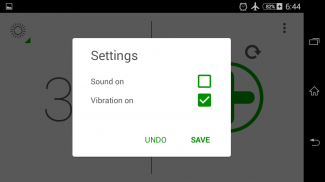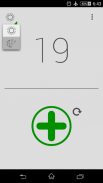








Sebha Counter | Praise The God

Description of Sebha Counter | Praise The God
a very light App helps the user to :
- count his " Tasbeh "
- Remember the number after closing the application
- Day & Night Modes for protecting your Eyes
- Supports Arabic ( Indian ) Digits
- save the number after accidentally deleting it
- supports Vibration
______________
وَإِن تَعُدُّواْ نِعْمَةَ اللّهِ لاَ تُحْصُوهَا إِنَّ اللّهَ لَغَفُورٌ رَّحِيمٌ (النحل 18)
And if you should count the favors and Miracles Of Allah , you could not enumerate them. Indeed, Allah is Forgiving and Merciful. ( 18 )Surat An-Naĥl (The Bee)
* you can count Allah 99 names easily with the app
* What is Sebha ?!
The daily prayer ritual is the most conspicuous outward manifestation of the spiritual life of Moslems . Tasbih is an order contained in the Holly Koran ( Quran ) .
It is in the literature of the mystics and in the popular prayer-manuals called Azkar & Award that we learn what is “praying without ceasing.” To reach that ecstasy is the goal of the mystic; to multiply and facilitate the meditations that lead to it, we use a rosary “The Sebha”.
The proper name for the rosary in Islam is Sebha. It is derived from sabbaha, (to give praise); that is, to declare God free from every imperfection or impurity or from anything derogatory of His glory. The word was first used for the performance of supererogatory prayer and then, in post-classical literature, applied to the rosary used for this purpose.
The simplest and perhaps earliest form of the rosary in Islam was a string having ninety-nine shells or beads with a marker after each thirty-three, with which, by counting them, one performs the act termed al-tasb ih, i.e. the repetition of the praises of God. This generally consists in saying subhan Allah thirty-three times, al-hamdu-lillahi thirty-three times, and Allahu-akbar thirty-three times.
Nowadays the Sebha” is used by all classes of Muslims and in all lands. There is evidence, however, that its use was an innovation introduced centuries after Mohammed (sala Allah allayh wa salam), by Sufi circles and among the lower classes. Opposition against the use of the rosary made itself heard as late as the fifteenth century A . D . The rosary was taken as one of the strange new practices (Bidaa) in Islam which should not be countenanced. A special box is made where it is kept; a salary is fixed for some one to guard and keep it, and for those who use it for dhikr. . . . A special Sheikh is appointed for it, with the title of Sheikh al-Subha. To them it was bid‘a, that is, an innovation without foundation in the old Islamic sunna
A rosary is not only a religious object with a history but, it is, an ancient craft struggling to survive.
Description provided with the help of Sebha History Blog
http://sebhahistory.blogspot.com

























